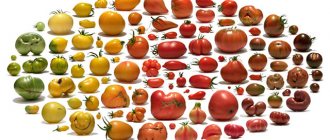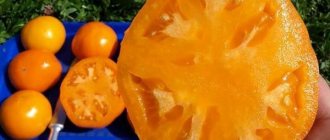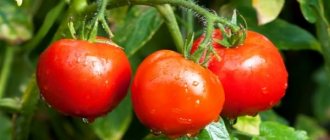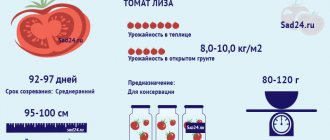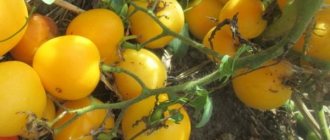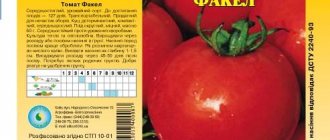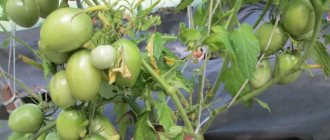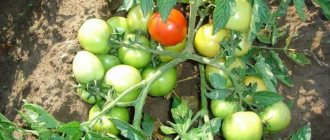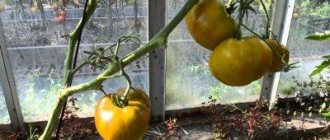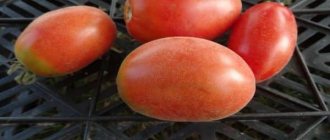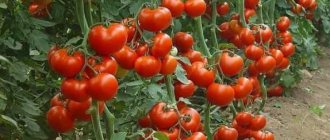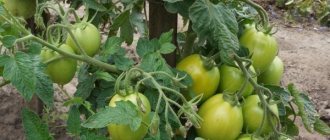Sometimes it’s great to grow tomatoes not only in garden beds. Yellow tom successfully bears fruit on windows and balconies. It is a popular cocktail variety. I like it fresh and canned.
| Height | Landing location | Ripening time | Fruit color | Fruit size | Origin | Fruit shape |
| short | Greenhouse, Open ground | Early ripening | Yellow | Small | Variety | Round |
Description and characteristics of the Snickers tomato variety, reviews, photos
A rare tomato variety with fruits of interesting color, shape and taste. In the middle zone, it is recommended to grow it in a greenhouse. In terms of ripening - mid-season.
The plant is of an indeterminate type, with a height of about 1.8 meters in closed ground. Requires tying to the support and pinning. The best results were obtained when forming a bush with 1 or 2 stems.
Basic qualities of fruits
photo author Natalya Ananyeva
The fruits are pepper-shaped (but wide) with longitudinal ribs, burgundy-brown in color at maturity, weighing 100-250 grams, fleshy, sugary at the break, pleasant tomato taste. Some fruits are truffle-shaped, with small voids inside. But in general, the tomato is not empty.
A cute and tasty domestic variety - Caspian pink tomato: reviews and description
Caspian pink is a productive and promising tomato from Kazakh breeders. It appeared in Russia and quickly became popular due to its wonderful taste, yield, and beautiful appearance.
| Height | Landing location | Ripening time | Fruit color | Fruit size | Origin | Fruit shape |
| Tall | Greenhouse, Open ground | Mid-season | Pink | Large | Variety | Flat-round |
Description and characteristics of the variety
The Caspian pink tomato is valued for its fleshy pulp and sweetish taste; it belongs to the group of indeterminate tomatoes. Among the characteristic features:
- tall, strong bushes (trunk height reaches 1.8-2.3 m);
- mid-ripening;
- large-fruited.
The fruits are juicy, marketable, suitable for a variety of fresh salads and snacks, preparations - juices, sauces, pastes.
What properties are inherent in tomatoes:
- average weight 300-400 g;
- maximum weight 600-700 g;
- round, flattened shape;
- matte crimson color;
- weak ribbing at the stalk;
- the pulp is sugary, fleshy;
- the taste is pleasant, with notes of sweetness and sourness;
- The skin is delicate but durable.
Advantages and disadvantages
- attractive appearance;
- excellent product and taste characteristics;
- transportability and keeping quality;
- resistance to cold weather, heat;
- complex resistance to pathogens;
- simple agricultural technology;
- stable, uniform harvests until the end of summer;
- large-fruited.
Minuses:
- need for regular watering.
Productivity
The Caspian pink tomato is famous for its harvests - up to 6-7 kg of large, fleshy tomatoes are harvested from 1 bush.
Landing
Seeds are planted in boxes or peat tablets starting in the first week of March.
Planting depth 1-2 cm. Water with a spray bottle and keep under film until germination.
Growing and care
Cultivation is carried out as follows:
- formation in 2 trunks;
- watering through a drip system;
- surface mulching;
- fixation to support;
- pinching once every 10-14 days.
Fertilizing is carried out before flowering, when setting and ripening. Alternate organics and minerals (nitrogen-phosphorus-potassium mixture).
Features of cultivation, planting and care
small voids are still present
We recommend sowing the seeds of this tomato variety for seedlings 60-65 days before the intended planting in the ground. Seedlings dive at the stage of two true leaves. When planting seedlings in a permanent place per 1 sq. It is recommended to place 3-4 plants per meter of plot.
Further care for tomatoes consists of timely watering, fertilizing with complex mineral fertilizer, pinching and preventive measures to protect against diseases and pests.
If you grew Snickers tomatoes, please write whether you liked them or not. What was the yield and taste of the fruits like under your climatic conditions? How do you rate the disease resistance of this variety? Briefly describe the advantages and disadvantages of this tomato in your opinion. If possible, attach a photo of your tomatoes to your comment. Thank you!
Your reviews of the Snickers tomato and additions to the description will help many gardeners evaluate this variety more objectively and decide whether it is worth planting or not.
Characteristics and description of the Rosanna tomato
The Rosanna tomato is a mid-season, determinate and productive variety that produces fairly large fruits. Tomatoes demonstrate excellent resistance to pests and diseases, and it is quite possible to grow them all year round in heated greenhouses.
The variety is included in the State Register of the Russian Federation as one that can be grown in greenhouse conditions or under film covering, only on personal subsidiary plots of land.
Tomato Snickers description reviews
We recently celebrated the New Year and it would seem that spring is still far away, but the gardener’s heart is already beating faster in anticipation of the planting campaign. But what varieties of tomatoes should you choose so that the coming year’s harvest does not disappoint?
Last year, the clear favorites when choosing seeds were tomatoes: Honey Drop, Black Moor, Mazarin, King of the Market2, Sanka, which justified themselves with a bountiful harvest. Perhaps only Mazarin disappointed many by not showing the declared qualities.
Feedback from gardeners on tomato yield results will give you an idea of many varieties of tomatoes. As a result of the analysis, you yourself will be able to compile for yourself a list of seeds that you will purchase for planting.
Positive reviews about tomato varieties
- Appetizing
from Sib.garden - the most delicious and productive. - Ox heart
- tasty large fruits, but very late. - Bonsai
from Gavrish (I bought 2 packs, but I couldn’t find them this season and my husband was whining all summer), - Bourgeois
- medium-sized tomatoes, 100-120g, but the bushes are productive, bear fruit from early July to mid-October, the taste is acceptable; - Ox heart
- tasty large fruits, but very late. I manage to shoot a couple of brushes in red - Budenovka
- liked it. Large, pink, fleshy, sugary. One of the first to ripen. The shape of the fruit corresponds to the name. The taste, I would say, is delicate, but not sweet. - Red giant
- large fruits (up to 800g first, but then not small), tasty; - Black pear
. It was the most abundant. Tomatoes (to our taste) turned out to be tastier than Gypsy/Chernomor, - De barao black
. I was very pleased. - De Barao
. Pink is tastier than red, beautiful when pickled (but not tastier than some other tomatoes), lies well, the skin, like all de Barao’s, is not thick, diseases do not stick. - Wild rose
- not a lot of fruit, but the taste is good, I didn’t get sick with anything; - Golden canary
- tasty, productive - Golden domes
are good in taste, but my yield was low. - Golden shower
is the shape of a small pear. They were noticeably larger in the greenhouse than in the greenhouse - Cossack
- light brown-pink, productive. - The King of Giants
and
Cosmonaut Wolves
impressed with their size and taste. Very dense, large tomatoes (even the last ones were at least 150 grams), sugary in structure, and can be stored for quite a long time.
I really liked the caramel The cluster is long, very decorative, the fruits are round, even, do not crack, the taste is excellent, pronounced tomato, sweet.- The malachite box
is sweet, fruitful, and extremely tasty. - Honey saved
is delicious, I’ll keep it, of course, but I wasn’t impressed with the quantity and suffered from crown rot. - Honey drop
- super! The fruits are yellow, resembling a drop of honey. Rich brushes. - Eagle's beak
is an excellent, delicious tomato, a very productive variety. I will definitely leave it. - Pepper-shaped
; Weighty, tasty, meaty and sweet tomatoes were simply sold out with a bang. I’ll definitely plant it in the new season! - Parsley gardener
is short-growing, the tomatoes are not large, the taste is similar to my favorite pink honey, quite productive (but not super-super), most of all suffered from blossom end rot. - Pink honey, Sevruga, Mazarin
- identical heart-shaped ones, but Sevruga is still among the favorites. - Pink Andromeda
- as an early variety it was an excellent variety, it bore fruit for a long time, but the quality of the first harvests was better; - Pink honey
is unproductive, but the most delicious, beloved. - Pink helmet
- tastes similar to pink honey, but smaller and just as barren. - Sonata
- productive, tasty - Semko-Sinbad
- the pickled ones turn out really good! - Supersteak
- the fruits have not grown to the stated size, but the clusters are 6-8 pcs and all the tomatoes are the same, the bushes are strong, the garter is minimal (the taste, however, can be better); - Sanka
is a very abundant variety, the taste is good. Good in bed. I'm leaving it! - Santa Claus
- pleases every year, but the fruits become smaller (a feature of the variety), tasty, very sweet; - Sweet Cherry
- very sweet, cheerful berries! Red ones are larger than yellow ones, but yellow ones are sweeter. - Persimmon
- beautiful, fleshy, productive, did not hurt. The variety is very good, I have had it for 8 years, year after year it gets better, no green spot, moreover, the place where the stalk is attached is tiny. - Nocturne and Intuition
(hybrids) are abundant and last a long time. - dates
are very productive, you’ll be tortured to harvest them. They were the first to ripen. The taste is sweet and sour. I didn’t like the fact that when overripe, the peel wrinkles and becomes very tough. - Black Moor
is tasty, productive, unpretentious, ideal for pickling and is a delight to eat fresh! - the Gypsy
- I planted it for 3 years, it’s a tasty harvest, it sets fruit both in the heat and in the fall. Quite resistant to late blight, mildly affected in late autumn. - Um the champion
is great. tasty, productive, early (on par with Sanka), completed at the end of August, stepson up to the first brush. The only drawback is that ripe fruits are not stored at all. But for juice or ketchup, in salads - just right!
Read also: Linden pruning in spring price
Didn't like these tomato varieties
- Atlantis
(SibSad) - terrible small (50-60 gr.) sour, on a powerful and strong trunk, although it didn’t hurt. - Boni MM
- I didn’t like it at all, neither in taste nor in quantity, and I didn’t have it at all early. - Bobcat and Slot
are productive, but the taste is the most common, market one. - Boogie - woogie
- not early and tasteless. - Yellow cherries
- tasty, sweet, lots of them, but very small and almost all of them were cracked - Irishka F1
(Russian vegetable garden) - cold-resistant, unpretentious, so-so, nothing special. - Koenigsberg red
- suffered from blossom end rot, low yield. - A Moscow delicacy
- very tasty, meaty icicles. Not very productive. Sick with Koenigsberg from apical rot - Honey-sugar
(SibSad) - “oak” store-bought tomatoes, although yellow in color, lasted the longest on the windowsill, but the taste changed for the worse. - The mandarin duck
was not impressed, in my opinion the honey drop is better, although the tomato is half the size. - Mazarin
was not impressed. - Eagle Heart
- I got sick first, I didn’t get any tomatoes. - Pink Leader
is the worst variety of this year in terms of fruit taste and yield. - Siberian Lights
- large cream, but empty inside - Timofeich
- fruitful, sweet and sour taste - Wonder of the world
- a lot of tomatoes, bears fruit for a long time, is unpretentious. Beautiful fruits with a spout. The taste is sour both in salads and in preparations. In salads, the juice is white-yellow-watery. LET'S CLEAN UP! - Jason
(Zedek) - tasteless
Share with your friends!
February is the right time to select and purchase tomato seeds, which we will sow in March. I have been growing tomatoes in a greenhouse and in open ground for only 6 years, but I have already managed to create my own hit parade of tomato varieties.
Tomatoes Pozzano F1. Photos, descriptions and reviews.
The Rosanna tomato is a mid-season, determinate and productive variety that produces fairly large fruits. Tomatoes demonstrate excellent resistance to pests and diseases, and it is quite possible to grow them all year round in heated greenhouses.
The variety is included in the State Register of the Russian Federation as one that can be grown in greenhouse conditions or under film covering, only on personal subsidiary plots of land.
The Rosanna tomato is an early-ripening and low-growing hybrid. The height of tomato bushes can reach from 0.7 to 0.8 meters. The stems are quite stable, strong and powerful. Experienced breeders recommend forming them during growth, and only into 1 or 2 trunks. It is the formation that can increase productivity.
The plant is spreading, so bushes are planted using a 50 to 40 technology. Thus, gardeners can plant up to 4 sprouts per square meter.
As for the period from seed germination to fruiting, it is approximately 95-105 days. The first tomatoes can be picked on the 90th day.
The foliage is light green, slightly corrugated.
The tomatoes take on a large, rounded shape and you can see the slight ribbing of the barrels. Inside the pulp is fleshy, juicy, sugary. The skin is quite dense, but tender and smooth.
If we talk about productivity, farmers say that it is possible to harvest almost 12 kilograms of tomatoes from one square meter.
The Rosanna tomato is considered a hybrid with excellent taste. Suitable not only for cutting fresh on the table and adding to salad, but also for preparing various dishes, soups, purees, tomato juice, sauces. It tolerates heat treatment well and is used in many restaurants around the world.
The Rosanna tomato tends not to crack in the beds, but besides this there are other advantages. Among them:
- High transportability over long distances.
- Excellent taste, pleasant and fragrant aroma.
- Tomatoes are consumed either fresh or pickled, and preserved in jars for the winter.
- Excellent presentation - approximately 90 to 95 percent.
- High sugar content.
- Attractive looking tomatoes.
- Growing both in greenhouses and under film coverings.
The only drawback is the whimsicality in care and feeding. You will have to spend money on this, because the Rosanna tomato loves clay soil and mineral fertilizers, which will protect against late blight.
Growing and care
Rosanna tomatoes are sensitive to sun. They love warmth very much, so in winter they should be grown in greenhouses, which are additionally heated and illuminated. This helps determine the rate of growth, maturation and yield itself.
As for soil humidity, in order for tomatoes to develop normally, it is necessary to ensure an air temperature of no more than 50 or 60 percent (in the first 12 weeks it cannot be exceeded by more than 65 percent). If you exceed it, then be prepared for the fact that pollination on flowers will deteriorate, and there will also be a risk that foliage and fruits will fall off.
This is how you expose your plants to fungal diseases. It is better to cultivate the land by adding humus to it and then the yield will be in the range of 12 to 16 kilograms per square meter.
Experienced breeders advise planting seedlings in a permanent place if the seedlings have already reached at least 25 or 30 centimeters. We must not allow the seedlings to become overgrown and thin, as this will lead to loss of yield. Do not thicken the planting; more than 6 tomato bushes will be too much.
READ MORE: The largest horses in the world: breeds and representatives
Do not forget to water when the soil is dry, but if there are sudden changes in climatic and weather conditions, it is better to temporarily refrain from watering.
“I am a farmer and grow the Roseanna variety for sale. I try to grow tomatoes without adding chemicals, so I prepare for the gardening season in advance. First of all, I organize the beds, which I carefully prepare for planting seedlings.
The best ones were the “warm beds”. What does it mean? It's simple, I take and place cardboard at the bottom of each hole. Then I add a layer of sawdust on top - about 10 centimeters. Next, I lay hay or fresh grass on the sawdust.
I add a layer of 30 centimeters and compact it all. It is very effective, because such sifted humus, or as it is also called compost, mixed with ash and soil, is the best.
They need to be watered with additional water, and at the same time they can work for up to 3 years, after which you do not need to add any fertilizers for yourself and your family. I grow it successfully, the only thing I do is carry out preventive work against late blight, because the variety, unfortunately, likes to be affected by this disease. So, I heat-treat the seeds. First, I infuse them in warm water at a temperature of about 50 degrees Celsius for 27-30 minutes.
I plant the sprouts farther apart from each other so that there is no need to pick (this process only delays the development of tomato bushes for 10 days), but I really don’t have enough time to prevent the tomatoes from catching the disease - late blight.”
Pests and diseases
Tomato "Rosanna" is highly resistant to the following pests and diseases:
- verticipillous wilt;
- tomato nematode;
- fusarium wilt;
- tomato tobacco mosaic virus;
- cladosporiosis;
- Alternaria leaf spot.
Less resistant to late blight and Colorado potato beetles, which simply adore tomatoes.
Storage rules
There are several tips from experienced breeders on how to store the Roseanne variety hybrid. So, if you store ripe fruits, it is better not to do this for more than two days.
They should be stored at room temperature, away from each other (so that they do not touch).
If you are storing unripe tomatoes, leave them in a regular room until they become fully ripe.
If you are growing Rosanna tomatoes for sale, you should keep them in a cellar or refrigerator or other cold room. This must be done in special wooden boxes.
One of the latest developments in Siberian agriculture. The variety is mid-season, ripening period 110-120 days, determinant (limited growth), medium-sized. The advantage of determinants over tall varieties is that they are unpretentious to grow and require minimal effort in care.
Designed in accordance with the climatic conditions of Siberia, cold-resistant.
It is grown both in open ground, in the southern regions, and in greenhouses or under film covers in mid-latitudes.
- Seeds for seedlings are sown in mid-March from the 10th to the 22nd. If you sow seeds ahead of schedule, the seedlings may stretch out, turn out weak, have difficulty adapting to a new place, or even die. If sowed late, small seedlings may not take root. Before planting, the seeds are treated with biological preparations such as Fitosporin.
After sowing, the seeds are well watered, covered with film and placed in a dark, warm place with a temperature of about 25 degrees.
Then, when the shoots appear, the film is removed and the seedlings are moved to a bright place.
- In the phase of 1-2 leaves, the seedlings are picked and transplanted into a large container. Then place the box of tomatoes in the shade for about one week.
When watering small seedlings, do not over-moisten the soil; after the 5th leaf appears, you can increase watering.
Tomato sprouts need hardening; a week before planting, take the plants out to the balcony or enclosed terrace.
- At the age of 60-65 days, when the sprouts already have 6-7 true leaves and at least one flowering branch, the tomatoes are planted in open or protected ground.
When arranging tomatoes of this variety, you need to take into account that they grow strongly, so per 1 sq.m. Land should not be planted with more than 2 plants.
- The fruits of this variety reach full maturity 110-120 days after emergence. This period is the growing season of plants.
Water the plantings with warm water, without waterlogging; when the fruits begin to form, the plant will require an increase in the amount of watering.
- After 3 weeks after transplantation, the plant is fed with organic fertilizer of the “Ideal” type, containing potassium, since if there is a lack of potassium, yellow spots form on the fruits.
In order for nutrients to reach the plant faster after fertilizing, it is necessary to loosen the soil and mulch it.
Description of the plant
Tomato bushes of this variety are low-growing, strong, plant height is from 70-110 cm, the bush contains a large number of ovaries. When grown, a trunk of 2-3 stems is formed. Despite its short stature, the tomato should be tied to a support and pinched, so it grows strongly.
If pinching is not carried out in time, then all the minerals obtained by the tomato will be spent on the development of the bush and leaves. The plant will have many fruits, but small ones that will not have time to ripen.
Description of fruits
This variety is highly valued by pink tomato lovers for its high taste. Ripe fruits are bright pink in color, beautiful, fruit weight ranges from 200-600 grams.
However, there were specimens weighing about 800 grams. The shape of the fruit is round, slightly flat, with slight ribbing.
The tomatoes taste sweet, the flesh is “fleshy” with a small content of seeds inside, and the cut is incredibly juicy.
Productivity
The variety has high productivity. In greenhouses with 1 sq.m. About 5 kg of tomatoes are harvested; in open ground the yield is slightly reduced.
The best varieties of tomatoes
There are must-have varieties that I always plant every year. I like them not only for their taste and unpretentiousness, but also for the way they look on the bush. I’ll paraphrase one bearded joke: “I don’t really like tomatoes... But the process itself...”. I love going into the greenhouse and admiring the tomato plantations. And I don’t hesitate to show off my particularly spectacular huge tomatoes to my neighbors, and then post photos on the forum. It’s a shame to hide it – we all love it!
The following varieties are among the favorites also because they do not need to be fanatically cultivated and shaped. And they will always give a harvest: small, large, and a lot, depending on the variety and what I grow them for - for salads, for preparations, or, the smallest and sweetest ones, so that “like seeds, they click.” .
The “Rocket” variety is suitable for both greenhouses and open ground. The fruits are identical in shape and sweet. We love to eat them by the handful. Look good in blanks. The bush requires garter, despite the fact that the package says the opposite. This is because a lot of fruits grow, and the bush bends from the weight. Its height in open ground is about 40 cm, and in a greenhouse it can reach up to 60 cm. This is a mid-season variety; it does not need to be pinched.
Rice. 1. “Rocket” matures smoothly and is well stored in both technical and biological maturity.
I got the “Big Man” variety During a tour of her greenhouse, I really liked the way it looked on the bush. The neighbor said that she has been planting it for a long time, that it is unpretentious and always sets fruit, even if the ventilation regime in the greenhouse is not followed. Of course, I took one fruit for seeding. “Zdorovyak” can grow up to 100 cm in height, so it is better to grow it in a greenhouse, although it produces large tomatoes in open ground.
Read also Goat meat benefits and harms
Rice. 2. There is almost no need to pin the “Big Man” wrist.
Rice. 3. It ripens in batches, gradually, which is very convenient.
Among the vigorous-growing tomatoes with large fruits, I singled out the variety “Red Giant” . This amateur variety was bred by simple gardeners. Despite the fact that it grows a lot of leaves, it does not have to be pruned too often. The fruits on the lower tiers are the largest. If I had not been lazy and plucked out the inflorescences, leaving no more than 3-4 in the brush, the fruits would have been even larger. It is fleshy inside and contains few seeds.
Rice. 4. “Red Giant” in mid-July.
Rice. 5. You can take your own seeds, but the fruit must ripen on the bush and come from the second cluster from the bottom.
Rice. 6. The fruits are slightly ribbed, quite transportable, there is never a yellow-pink top from unbalanced care, as in pink-fruited varieties.
Rice. 7. Both the side of the stalk and the reverse side always have a marketable appearance.
Rice. 8. The only drawback of the “Red Giant” is that the largest fruits require a garter.
However, almost all large-fruited tomatoes require additional tying of the brushes. Except for my next favorite, Bull's Heart . I also always grow it year after year, as my grandmother advised me. “He will never let you down!” - she said, and every year I am convinced of this. Even if I took my own seeds and not factory ones, “Bull’s Heart” invariably bears fruit and does not require pinching at all, although it is vigorous. Somehow I didn’t have enough space in the greenhouse, and one bush of “Bull’s Heart” grew on the street without shelter. It grew to 1 m instead of 140-150 cm in the greenhouse, but still pleased me.
Rice. 9. The hands grow in such a way that they do not need to be additionally secured with a garter to prevent them from falling.
Rice. 10. There is one feature of the “Bull’s Heart” - a predisposition to the formation of such gnarled fruits.
Therefore, if you see a bud or flower that is too large, feel free to cut it with scissors, it will still take a long time to ripen, even though it will be large, the skin will be hard and gray, you cannot take seeds from it.
Rice. 11. But the bulk of the “Bull’s Heart” fruits are very beautiful, tasty and fleshy. By the way, this variety comes in both orange and red.
Main types of tomatoes
Let's take a closer look at each variety.
Standard
These are the shortest tomatoes, distinguished by their compact bush size and thick stem. Standard varieties are not the most productive varieties; their main advantage is their early ripening.
The main advantages of the type include:
- resistance to adverse factors - drought, frost;
- thick stem, thanks to which the plant does well without tying;
- tight fit due to compact size;
- shallow roots, allowing active absorption of water and additional nutrients;
- good transportability of fruits.
Standard crops are grown mainly in greenhouses and greenhouses; it is advisable to plant them in open ground only in the southern regions.
Standard varieties include the following varieties:
- Cameo is an early-ripening variety with smooth fruits, juicy pulp and a pleasant aroma.
- Buyan - the average weight of cylindrical fruits is 90 g. Excellent for preservation, resistant to the vagaries of weather, tobacco mosaic.
- Yamal is characterized by increased resistance to diseases and pests. With proper care, you get a good harvest of dense, rounded fruits weighing 70-100 g.
Indeterminate
The stem of indeterminate tomatoes reaches 2-4 m in height, so varieties must be tied up. To limit the plant's growth, pinch the top of the stem. This variety is characterized by long-term fruiting; in heated greenhouses, the plant bears fruit throughout the year.
Advantages:
- high yield - 14-17 kg/m²;
- stable immunity to fungal diseases and the vagaries of nature.
The disadvantages include the mandatory strict adherence to the rules of agricultural technology, especially when forming a plant bush.
Among the many indeterminate crops there are:
- Angel F1 is a new domestic hybrid without restrictions on the region of cultivation, early ripening, for salad purposes. It is characterized by high productivity, good immunity to fusarium and verticillium.
- Belfast F1 is a popular early-ripening hybrid, immune to cladosporiosis, fusarium, tobacco mosaic, and tolerates transportation well. The fruits weigh an average of 210 g, do not crack, and the yield is high - up to 26 kg/m².
Tomato Angel F1
Other indeterminate varieties and hybrids are Walford's Miracle, Crushed Heart, Tyler f1, Lion's Heart, Star of Siberia.
Semi-determinant
Semi-determinate plants stop growing at about 10-12 inflorescences, are characterized by high productivity, do not require complex care, and are suitable for greenhouses and open ground.
A distinctive feature of the species is short internodes.
Among the many semi-determinate varieties are:
- Magnus is an early variety with tasty fruits and is considered ideal for canning.
- Silhouette is a greenhouse hybrid; its small fruits are perfectly stored and transported.
- Red Arrow is one of the most unpretentious varieties, suitable for canning and summer salads, and is characterized by high yield.
- Zinulya is a mid-season variety with large and sweet fruits.
Tomato Magnus
Determinant
Determinate tomatoes are varieties that stop growing when a cluster of flowers appears at the top. The height does not exceed 80 cm. They are grown everywhere: in the southern regions - in open ground, in other parts of Russia - in hotbeds and greenhouses.
Such plants bear fruit once per season for 1-3 weeks.
The main advantages of determinate tomatoes:
- precocity;
- high productivity;
- friendly return;
- low maintenance requirements;
- possibility of cultivation even in northern regions;
- suitability for canning.
The disadvantages are quite controversial - some vegetable growers consider determinate tomatoes less tasty.
The best varieties of determinate tomatoes:
- Alsou is a mid-early, large-fruited variety. Grown in open and closed ground, yield up to 9 kg/m². Used fresh and in salads.
- Gina TST is a mid-season variety that does not require pinching for film greenhouses and open ground. Resistant to cracking and disease, suitable for canning and fresh consumption.
- Lyubasha F1 is an ultra-early hybrid of universal use, resistant to cracking and disease, suitable for growing in open and closed ground. It has a high yield - up to 20 kg/m².
Tomato Alsou
Tall tomatoes for the greenhouse
I definitely plant the listed varieties, but there are also some that I just liked, and I periodically grow them in the greenhouse, but I have not become a fan of them. Of the indeterminates, I like the raceme varieties the most. Again, this is primarily because they look beautiful on the bush. There are only three varieties, and each has a special reason to grow it.
“Intuition F1” is a mid-season hybrid, but I would classify it as a late-season hybrid. Not only does it reach harvest ripeness only by mid-August, but biological maturity also comes quite late. Some specimens of these tomatoes ripen even until the end of October. But, on the other hand, this is convenient because as a result, we have our own fresh tomatoes at home for a very long time. That's why I sow it in February.
Rice. 12. Photo from the end of July, but the fruits have not yet begun to ripen.
But “Intuition F1” is very easy. This hybrid is great for freezing for future use. In winter, I make pizza and frittata with them, as they do not defrost like porridge, but retain their meatiness well when cut.
Rice. 13. The fruits are all smooth and beautiful.
Rice. 14. In this form, I send “Intuition F1” to deep freeze.
“Scarlet Candles” is a cluster variety, mid-season. They don’t have a special taste, but what a shape! Looks impressive in preparations with cucumbers. However, this is why I grow them. It’s nice to admire such a jar later in the winter.
Rice. 15. The length of “Scarlet Candles” is almost like pickling cucumbers.
Rice. 16. “Scarlet candles” look neat, they all have a characteristic “spout”.
“De Barao” is quite late-ripening; I sow it earlier than the bulk of tomatoes. I really like it in preparations, it does not crack and is very tasty, both fresh and pickled.
Rice. 17. "De Barao" is resistant to disease. I always plant it on the north side, tying it above the entrance to the greenhouse, because it is very tall, and the upper tier ripens even in the last ten days of August, despite the first cold nights.
Rice. 18. The fruits are beautiful, all as one.
I have tried a great variety of salad varieties, I still want to find the most delicious one. Of the unusually colored tomatoes, I really like the taste of Malachite Box and Black Prince . Both are tall and require pinching, gartering, and formation into 1-2 stems, but the effort is worth it, the fruits are magnificent. “Black Prince” is dark burgundy when fully ripe.
Read also Tomato sugar bison reviews photos yield
Rice. 19. “Malachite box” in biological maturity – green.
Rice. 20. All these “Malachite Box” tomatoes are already ripe, although in appearance they seem unripe.
The yellow giants are not inferior in taste, of which the most fleshy and tasty for me are “Yellow Truffle” - of an unusual shape, “Persimmon” - indeed, the pulp is cut like the fruit of the same name, “Golden King” and sweet as a melon, “ Golden Bull" . “Golden Heart” and “Altai Yellow” were less impressive But it should be noted that the shelf life of yellow tomatoes is inferior to red ones. From salad reds, I grew “King of Large”, “Cardinal”, “Canary”, “Bear’s Paw”, “Mazarin”, “Altai Red” . What can I say about them - they are all equal, as if they were selected. It tires them to constantly tug and tie them up. One good thing is that they are large.
Rice. 21. Everyone looks the same on the bush. This is Cardinal.
Rice. 22. “Cardinal” is well kept.
Rice. 24. In the foreground is “Mazarin”. It differs only in shape, in taste - like all other red-fruited ones.
Rice. 25. “Altai Reds”, however, can be praised for their friendly maturation.
Separately, I would like to mention the pink-fruited tomatoes “Miracle of the Earth”. If you are lucky with the summer and it is not very hot, then you can get a good harvest from this variety.
Rice. 26. “Miracle of the Earth” are also tall.
But, if there is not very good ventilation in the greenhouse, then this variety will give a characteristic light yellow border, I don’t like it, and I cut it off before use.
Rice. 27. “Miracle of the Earth” - on the right. They are the same size as the Red Giant on the left.
Separately, it should be said about tall cherry tomatoes, for example, “Chio-chio-san”, “Sweet Cherry F1” and others. Yes, many of them are sweet, they look elegant both in the greenhouse and in pickles, but many of them are thrown away and require careful care. No matter how much I refuse to plant them, I still “break down”, I really want to admire the brushes.
Rice. 28. “Red date” is, of course, delicious.
Rice. 29. “Goldilocks” also tastes good if you resist and don’t eat it half-ripe - and it can be eaten even half-ripe.
Description of the hybrid tomato Rosanna and tips for growing the variety
Tomato Rosanna F1 is a hybrid variety that was bred by Russian breeders. It belongs to the mid-season species, limited in growth. The tomato brings the farmer a rich harvest. It can be grown in open ground during the summer season or in a heated greenhouse year-round.
What is a Rosanna tomato?
Characteristics and description of the variety:
- The bushes do not grow higher than 80 cm, since Rosanna is a determinate tomato.
- The plant has a strong and stable stem.
- Experts recommend ridding the hybrid of stepsons, forming it into 1-2 stems to increase productivity.
- It is recommended to tie the bushes to a support, as they produce quite massive fruits.
- The bush has light green leaves that darken slightly as the plant grows stronger and taller.
Now let's look at the characteristics and description of the fruits of the Rosanna tomato. The fruits are pale pink in color and grow to medium size. The tomato is round in shape, slightly ribbed on the sides. The pulp is dense and the taste is sweet. The peel is highly dense, so that even fruits that are overripe in the garden will not crack and can be transported over long distances.
A large number of reviews indicate that tomatoes have a delicate taste and are characterized by a pleasant smell. Tomato can be eaten both fresh and as an ingredient for salads, and as tomato sauce, juice and puree. This variety is also suitable for pickling and pickling. You can preserve tomatoes in jars or salt them in barrels so that you can eat them in the winter.
Farmers who grow tomatoes for sale also often prefer this variety, primarily for its good aesthetic qualities and the possibility of long-term transportation, as well as due to its unusual taste. Up to 6 fruits grow on a cluster, each tomato weighs about 200 g. From a plot of land of 1 m² you can collect up to 12 kg of ripe tomatoes.
Tomatoes for open ground
Among the tomatoes for growing outside, I liked only five. Although all tomatoes for open ground can be grown in a greenhouse, if there is space. It is simply more efficient to occupy a greenhouse not only in width, but also in height, so it is customary to place low varieties outside, under temporary shelter or without it at all.
The hybrid “Market King III F1” got its name for a reason. I grow it under cover and without, depending on how much space remains in the greenhouse after the main plantings. It is considered early ripening, although I would not say so. I plant it with pleasure, because in any summer - both cloudy and hot - it produces a stable harvest. Most likely, this is because it is resistant to various diseases. In a greenhouse it grows slightly higher than in open ground. A garter is needed because the fruits, especially the lower ones, are very large.
Rice. 30. “Market King III F1” produces aligned fruits (in the red basket).
Rice. 31. “Apple tree of Russia” on a bush.
Rice. 32. “Apple Tree of Russia” stores well, including when frozen.
Rice. 33. “Buyan” is a long-known trouble-free variety for open ground.
Rice. 34. “Buyan” is good for pickling.
Rice. 35. I bought “Leningrad Chill” in economical packaging - 200 seeds in one. It lived up to its name, did not freeze during frosts, and grew well both in the greenhouse and outdoors.
Rice. 36. But the yellow-fruited variety “Wonder of the World” turned out to be the most cold-resistant for open ground. It sets an incredible amount of fruit.
From the low ones I also tried “Kremlin F1”, “Peach”, “Orange Sun”, “Dushechka”, “Tiger”, “Sanka” . Despite the hype, these varieties disappointed me.
And finally, dwarfs. These tomatoes are suitable for even the laziest or busiest gardeners. They do not require gartering, watering and, especially, pinching.
Rice. 37. Dwarfs only need to be mulched in mid-June and come to harvest in early August.
Rice. 38. Although, if you sow them at the end of February, you can harvest the first harvest on July 1, as in this photo.
Rice. 39. They bear fruit all summer.
I tried “SamRastet”, “Florida Petit”, “Pygmy”, “Pinocchio”, “Balcony Duet” - I liked them all.
Rice. 40. “Florida Petit” bore fruit even at home.
This year I will have only three new products: the tall “Shuntuk Giant” and the standard “Far North” and “Winter Cherry” . All of them have good reviews on the forum.
Do you have any tomato varieties that you must plant every year? How many are there, and what are they called?
According to ripening time
Like all other vegetable crops, tomatoes are classified according to ripening time.
Ultra early
From the moment the first shoots appear to ripening, 75 to 85 days pass. As a rule, these are low-growing tomatoes with small fruits. They are not famous for their high productivity; they are suitable for regions with short daylight hours.
It is worth considering for planting such super early tomatoes as:
- A gardener's dream is a disease-resistant, multi-purpose, productive variety. Requires gartering and pinching. The fruits are juicy and sweet.
- Greenhouse early ripening F1 is a hybrid tomato for universal use, the fruits are dark red with a slight bitterness.
Tomato Gardener's Dream
Early
Early tomatoes are harvested 90 days after emergence. The pulp of these vegetables is sweeter than that of the ultra-early ones. The varieties are suitable for growing in temperate and cold climates.
Early ripening varieties and hybrids of tomatoes that have won the love of gardeners:
- Barberry F1 is an early-ripening indeterminate hybrid for greenhouses; it requires staking and pinching. The fruits are oval-shaped, juicy, collected in large clusters of 50-70 pieces. Fruits until autumn.
- Big Mom is an early, determinate variety for open ground and greenhouses. Requires gartering and pinching. A unique combination of early ripeness and large fruit, yield up to 9 kg/m².
Tomato Big Momma
Mid-late
The ripening time for mid-season tomatoes is 100-115 days from the date of emergence. These varieties feel great both in open ground and in greenhouses.
Some of the most popular mid-late varieties are:
- Altai masterpiece - the fruits weigh on average 400 g, taste pleasant and delicious. The plant is tied up and pinched.
- Rosemary F1 is a hybrid with high productivity, rich in vitamin A, and is immune to cladosporiosis and fusarium.
Tomato Altai masterpiece
